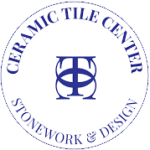The story of the manufacturing process of the products we sell and their proper applications.
Porcelain Tile
In my last blog, I referenced more details on materials and their proper applications. This can be a dry subject, so I will inject as much fun as possible so you don’t fall asleep. Porcelain is a natural material composed of clay which is kaolin. Kaolin is a soft earthy material, usually white, and has the mineral feldspar in it, I know, riveting. Porcelain also has colored pigments which are finely ground and sand. But wait, there’s more! The Powerhouse, The Dwayne “The Rock” Johnson of porcelain is andesite, easily translated to concrete.
Now, remember how much fun it was to play in the sand. That’s what is happening next. The components are mixed in specific ratios, and water is introduced and mixed in a large barrel. After thoroughly mixing, it is put through a press and has 400 kg or 881.849 pounds of pressure applied as it goes through the press. That’s a lot of pressure! It then enters a conveyor belt where the press material is cut into the shapes needed.
The tiles now go through a drying process to remove moisture before it is put in the Kiln. It first gets a primer applied and then either a screen printing with different layers of screens to add variation, or it is laserjet to produce the final images. The Inkjet is run through a computer that transfers the image to the finished tile. The tiles are then conveyed to the Kiln and fired at 1190 Celsius or 2000 degrees Fahrenheit for 22 hours. The tiles are then slowly cooled. If this process is rushed, the tiles warp and are considered inferior. The companies that try to save time and money are the ones that create inferior products. Shame on them!
So, Porcelain tile is the most robust product for any application. It boasts a less than 5% porosity rating. If you are installing on a wet area, always ask the tile store if the tile meets the ADA’s recommendation for the Coefficiency of Friction, also known as the COF. While this all seems a bit dry, it is essential to be informed before shopping for your project. Run if the tile store can’t answer these questions, to our Ceramic Tile Center, of course.
Now bear with me a little longer. School isn’t over just yet. There are interesting types of Porcelain Tile, Color Body, and Through-Body. A “Color Body” porcelain tiles Are created with continuous colored stains from the glaze surface throughout the body of the tile. Synchronizing the color of both the glaze and body lessens the visibility of any impact chips should they occur.
“Through Body” refers to unglazed porcelain tile. For example, the color on top goes all the way through. Even in extreme applications, like a car dealership floor, these tiles tend not to wear as the porcelain is quite durable. It is harder than granite,” unbelievable,” and the color goes all the way through.
Ceramic tile is composed of the primary materials as Porcelain tile except for the andesite, the concrete component. The next difference is the use of additional water and ceramic balls that dissolve when it is mixed. The blend then has an atomizer that starts to spray the slurry creating an atomized powder. It is much dryer as the moisture is removed with this technique.
Ceramic Tile
The ceramic tile also goes through a press and is then cut into the desired shapes for production. The ceramic tile is then glazed, which creates a glass-like product on the surface to prevent absorption due to the ceramics’ porous surface. Then the screened process is applied to create the pattern, and it is sent to the Kiln where it cures at 1190 Celsius or 2000 degrees Fahrenheit for 8 hours and will need to cool for 12 hours.
Ceramic Tiles are best used on walls only as it is not as strong as it’s Porcelain counterpart. Based on their compositions and time in the Kiln, it is easy to see that Ceramic Tile does not have the strength that Porcelain tile does. Well, it is time to take a break from tile class. School is adjourned! Thanks for being such good students and now informed consumers. You are so welcome!
I look forward to sharing more Pro Tips in my next blog.
Jamie Laughton Owner/Designer Ceramic Tile Center Stonework and Design.


